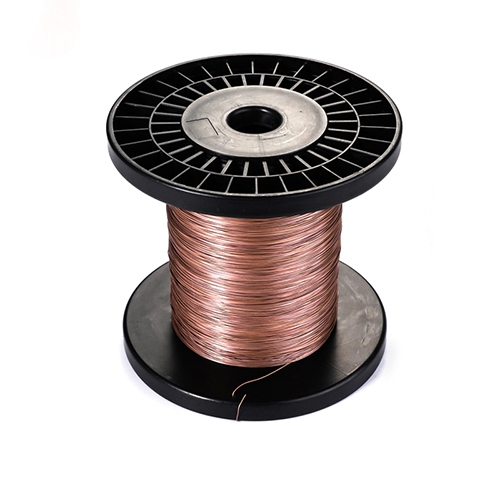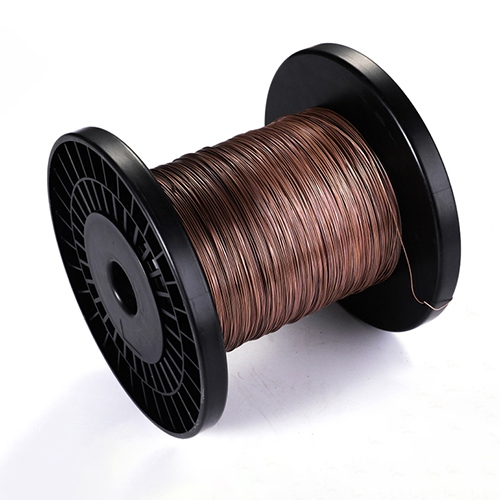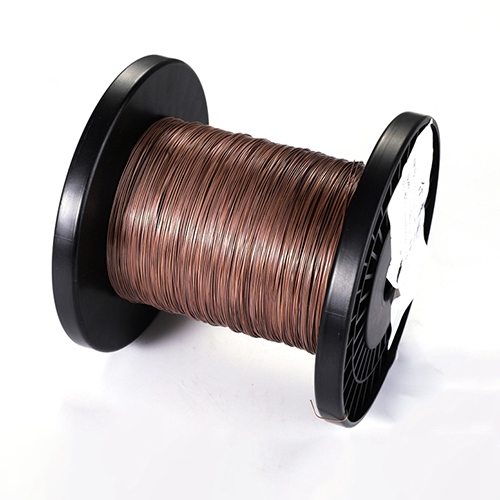Brass Mig Welding Wire is a MIG welding wire based on brass alloy (copper-zinc alloy), specially designed for welding copper and copper alloys, galvanized steel plates, dissimilar metals and other materials. It protects the molten pool with inert gas (such as argon) to achieve efficient and low-spatter welding, and is widely used in automobile manufacturing, electronic and electrical, shipbuilding and other fields.

●Cadmium-Free Brass Mig Welding Wire
| BrazingAlloys | AWS | Chemical Composition(%) | Solidus | Liquidus | Main Uses | |||||
| Ag | Cu | Zn | Sn | F | ℃ | F | ℃ | |||
| BAg5CuZn | 5 | 58 | 37 | / | 1545 | 840 | 1615 | 880 | Suitable for nickel-chromium alloy resistance components, brazing and heat treatment can be performed at the same time. Suitable for copper-based alloys such as brazing/cyanide hardening by changing instruments or joining steel parts. Suitable for steel, brazing and heat treatment at the same time. Low silver solder for ferrous and non-ferrous metals. | |
| BAg7CuSn | 7 | 85 | / | 8 | 1225 | 665 | 1805 | 985 | ||
| BAg10CuZn | 10 | 83 | 37 | / | 1499 | 815 | 1562 | 850 | ||
| BAg15CuZnSn | 15 | 47 | 37 | 1 | 1364 | 740 | 1526 | 850 | ||
| BAg18CuZnSn | 18 | 47.5 | 33 | 1.5 | 1436 | 780 | 1490 | 830 | ||
| BAg20CuZn | 20 | 45 | 35 | / | 1319 | 715 | 1499 | 815 | ||
| BAg25CuZn | 25 | 41 | 32 | / | 1292 | 700 | 1472 | 800 | ||
| BAg35CuZn | BAg-35 | 35 | 32 | 33 | / | 1265 | 685 | 1390 | 754 | |
| BAg38CuZnSn | 38 | 32 | 28 | 2 | 1200 | 650 | 1330 | 720 | ||
| BAg40CuZn | 40 | 30 | 30 | / | 1245 | 675 | 1340 | 725 | ||
| BAg40CuZnSne | BAg-28 | 40 | 30 | 28 | 2 | 1200 | 650 | 1310 | 710 | |
| BAg45CuZn | BAg-5 | 45 | 30 | 25 | / | 1225 | 665 | 1370 | 745 | |
| BAg45CuZnSn | 45 | 27 | 25 | 3 | 1185 | 640 | 1260 | 680 | ||
| BAg50CuZnSn | 50 | 20 | 28 | 2 | 1220 | 660 | 1305 | 705 | ||
| BAg56CuZnSn | BAg-13a | 56 | 42 | / | 2 | 1420 | 770 | 1640 | 895 | |
| BAg60CuZn | 60 | 25 | 15 | / | 1245 | 675 | 1325 | 720 | ||
| BAg25CuZnSn | BAg-37 | 25 | 40 | 33 | 2 | 1270 | 690 | 1435 | 780 | It has lower melting point, high strength, good brazing process and good overall joint performance. It can braze copper and copper alloys, steel and stainless steel as well as quenched and tempered steel with lower brazing temperature. |
| BAg30CuZnSn | 30 | 36 | 25 | 2 | 1202 | 650 | 1346 | 750 | ||
| BAg34CuZnSn | 34 | 36.5 | 27 | 2.5 | 1166 | 630 | 1346 | 730 | ||
| BAg40CuZnSn | BAg-28 | 40 | 30 | 28 | 2 | 1173 | 634 | 1364 | 740 | |
| BAg45CuZn | BAg-5 | 45 | 30 | 25 | / | 1229 | 665 | 1373 | 745 | |
| BAg45CuZnSn | BAg-36 | 45 | 27 | 25 | 3 | 1184 | 640 | 1256 | 680 | |
| BAg50CuZn | 50 | 25 | 25 | / | 1274 | 690 | 1427 | 775 | ||
| BAg50Cu | BVAg-6b | 50 | 50 | / | / | 1435 | 780 | 1600 | 870 | |
| BAg56CuZnSn | BVAg-7 | 56 | 23 | 16 | 5 | 1144 | 618 | 1205 | 652 | |
| BAg72Cu | BVAg-8 | 72 | 28 | / | / | 1434 | 779 | 1434 | 779 | |
●Cadmium-Containing Brass Mig Welding Wire
| BrazingAlloys | AWS | Chemical Composition(%) | Solidus | Liquidus | Main Uses | ||||||
| Ag | Cu | Zn | Cd | Ni | F | ℃ | F | ℃ | |||
| BAg18CuZnCd | 18 | 39 | 28 | 15 | / | 1184 | 640 | 1373 | 745 | Used for low-cost brazing of copper and copper alloys, steel and stainless steel. | |
| BAg20CuZnCd | 20 | 40 | 25 | 15 | / | 1121 | 605 | 1409 | 765 | ||
| BAg25CuZnCd | BAg-33 | 25 | 30 | 27.5 | 17.5 | / | 1124 | 607 | 1259 | 682 | Mainly used for brazing ferrous metals, nickel-based alloys and Cu-Ni alloys; it has good fluidity. |
| BAg30CuZnCd | BAg-2a | 40 | 28 | 21 | 21 | / | 1112 | 600 | 1274 | 690 | |
| BAg35CuZnCd | BAg-2 | 45 | 26 | 21 | 18 | / | 1121 | 605 | 1292 | 700 | |
| BAg40CuZnCd | 45 | 16.8 | 17.5 | 25.5 | 0.2 | 1103 | 595 | 1121 | 605 | ||
| BAg45CuZnCd | BAg-1 | 50 | 15 | 16 | 24 | / | 1124 | 607 | 1146 | 619 | |
| BAg50CuZnCd | BAg-3 | 50 | 16.5 | 14.5 | 16 | 3 | 1169 | 632 | 1270 | 688 | |
High conductivity: The conductivity of brass alloy is better than that of ordinary steel welding wire, which is suitable for welding conductive parts.
Corrosion resistance: Zinc element enhances the ability to resist atmospheric corrosion and prolongs the life of the weld.
Mechanical properties: Tensile strength ≥420MPa, elongation ≥22%, meeting the needs of high-strength welding.
Welding compatibility: Suitable for welding of dissimilar metals such as copper (red copper, brass), galvanized steel and stainless steel.
Low spatter: Stable droplet transition, spatter reduction of more than 50%, reducing post-processing costs.
High deposition efficiency: The deposition speed is 30% higher than that of traditional welding wire, shortening the welding cycle.
Beautiful weld: The weld is flat and the fish scale pattern is fine, without additional grinding.
Low smoke: The welding process reduces smoke, which meets the ISO 14001 environmental protection standard.
Non-toxic gas: Inert gas protection, avoids the formation of oxide scale, and reduces harmful gas emissions.
Use vacuum induction furnace to melt brass alloy and control the copper-zinc ratio (Cu 60%-70%, Zn 30%-40%).
Multi-pass cold drawing process, diameter accuracy of ±0.02mm, surface finish Ra≤1.6μm.
Copper plating: enhance conductivity, prevent oxidation, plating thickness 2-5μm.
Lubrication treatment: apply special lubricant to reduce wire feeding resistance and ensure continuous and stable feeding.
Chemical composition analysis: ICP-OES spectrometer detects the content of copper, zinc, lead and other elements.
Mechanical property test: tensile testing machine detects tensile strength, yield strength and elongation.
Metallographic inspection: observe the structure of welding wire under microscope to ensure no defects such as cracks and pores.
Radiator welding: replace traditional soldering, solve the problem of welding dissimilar metals of brass and copper, and improve heat conduction efficiency.
Battery connector: welding copper busbar and galvanized steel bracket to reduce contact resistance and improve battery pack performance.
Exhaust pipe repair: welding stainless steel and brass flanges, high temperature corrosion resistance, and extended service life.
Busbar welding: achieve high conductivity connection between copper busbar and copper terminal, reduce heat loss.
Transformer winding: welding copper wire and copper foil to improve electromagnetic compatibility (EMC).
Galvanized steel plate welding: replace resistance spot welding, avoid zinc layer burning, and maintain anti-corrosion performance.
Seawater pipeline: welding brass valves and steel pipes, resist salt spray corrosion, and ensure sealing.
Marine electrical appliances: welding copper terminals and galvanized cables to adapt to humid environments and reduce maintenance costs.
Copper sculpture: welding brass plates to achieve complex shapes without secondary surface treatment.
Galvanized steel structure: welding stair handrails and railings, beautiful welds and strong weather resistance.
Stainless steel and copper welding: used in food processing equipment, in line with FDA hygiene standards.
Pharmaceutical pipeline: Weld brass valves and stainless steel pipelines to ensure the purity of the medium.
Temperature: 15-25℃, humidity ≤60%, avoid direct sunlight.
Packaging: Vacuum sealed packaging, placed in a drying oven after opening, preheated to 100℃ 2 hours before use.
Wire feeding mechanism: Clean the guide wheel regularly and replace the worn clamping wheel.
Welding gun: Clean the nozzle every shift to prevent spatter from blocking the gas channel.
Current: Select according to the wire diameter (such as Φ1.2mm welding wire, current 120-180A).
Voltage: Match the current (such as 180A current corresponds to voltage 20-24V).
Gas flow: 15-20L/min, to ensure full protection of the molten pool.
Q: Can brass MIG welding wire weld stainless steel?
A: Austenitic stainless steel (such as 304, 316) can be welded. Welding parameters need to be adjusted and special gas (such as Ar+2%O₂) should be used.
Q: How to solve the problem of dark weld color?
A: Check the gas purity (≥99.996%), adjust the current and voltage matching, and ensure that the molten pool is fully fused.
Q: What is the minimum order quantity?
A: The minimum order quantity for conventional specifications (Φ0.8mm-Φ1.6mm) is 5 tons, and small batch customization is supported (15% mold fee is required).
Q: Do you provide technical support?
A: Welding process parameter tables are provided free of charge, and engineers can provide on-site guidance for the first piece of welding.


